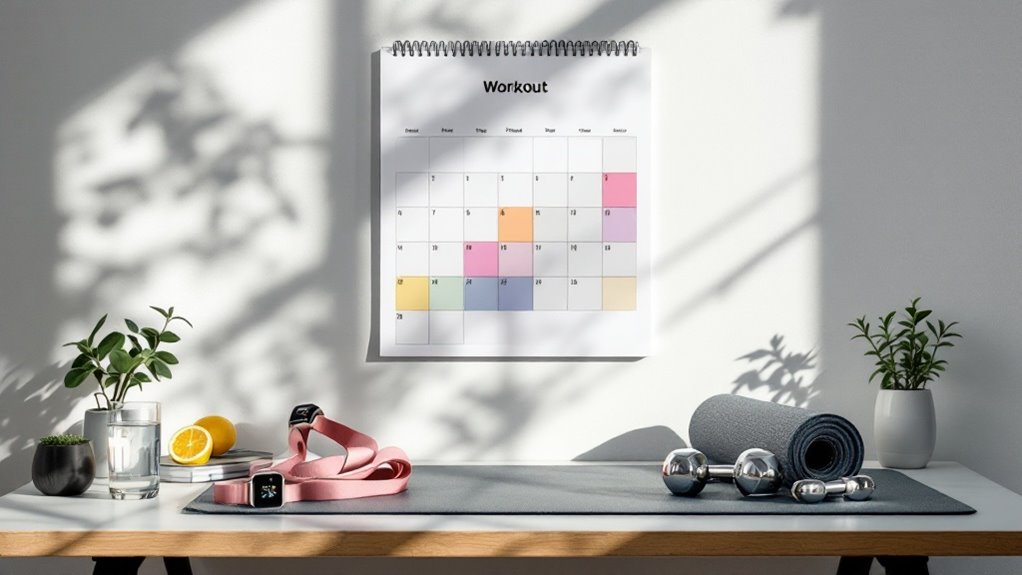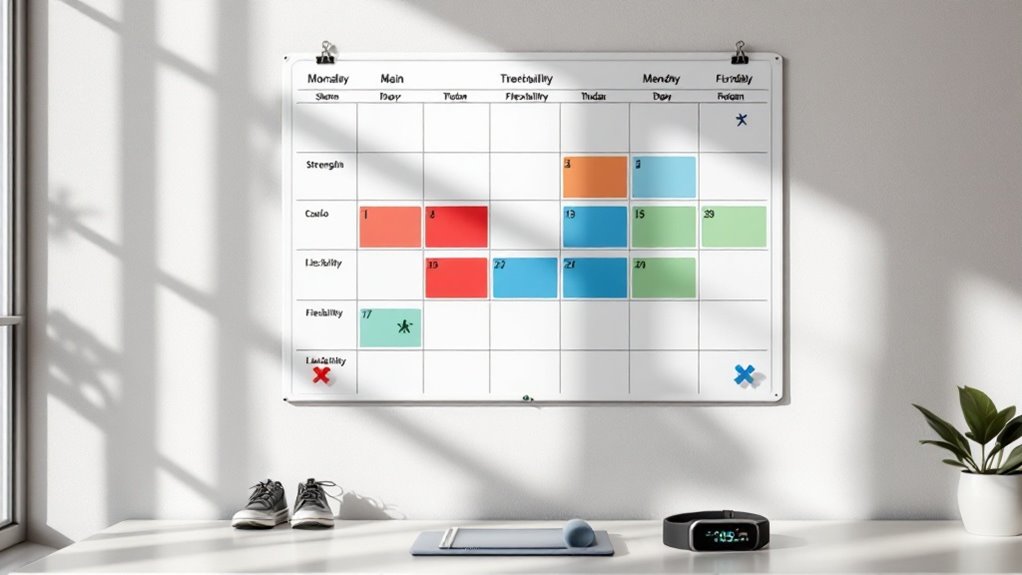Workout Calendar

A workout calendar transforms random exercise sessions into a structured path toward fitness success. This organizational tool eliminates decision fatigue by pre-planning workout types, intensities, and rest periods across weekly and monthly schedules. It creates accountability through specific time blocks while tracking progress toward measurable goals. By documenting exercises, rest days, and achievements, fitness enthusiasts maintain motivation and discipline. The journey to peak performance begins with strategic planning and consistent execution.
Key Takeaways
- A workout calendar tracks and schedules specific exercises, rest days, and workout types to maintain consistent fitness progress.
- Include detailed information for each session, such as exercise type, duration, sets, reps, and target muscle groups.
- Plan different workout types across the week, alternating between strength training, cardio, and flexibility exercises.
- Schedule rest days strategically between workouts to allow proper muscle recovery and prevent burnout.
- Track progress in your calendar to identify patterns, celebrate achievements, and adjust your routine when needed.
Benefits of Creating a Workout Calendar

Organization serves as the cornerstone of fitness success, and creating a workout calendar delivers multiple powerful benefits for anyone serious about reaching their health and fitness goals. A well-structured calendar guarantees consistent progress tracking, eliminates decision fatigue, and maintains accountability.
Like a military operation, a workout calendar creates structure and discipline in training efforts. It prevents workout overlap, balances intensity levels, and optimizes recovery periods.
The visual roadmap serves as both motivation and documentation, allowing individuals to identify patterns, celebrate victories, and adjust strategies when needed. This systematic approach transforms random exercise sessions into a purposeful journey toward peak performance. Following progressive overload principles helps ensure continuous improvement while preventing training plateaus.
Essential Components of an Effective Exercise Schedule

A well-designed exercise schedule consistently incorporates several key elements that work together to create a thorough fitness blueprint.
These components include designated training days, specific workout types, rest periods, and progression tracking.
Each week should balance cardiovascular activity, strength training, and flexibility work while allowing adequate recovery time.
The schedule must specify workout duration, intensity levels, and target muscle groups.
Including measurable goals and milestones helps maintain focus and motivation.
Proper scheduling also accounts for personal commitments, energy patterns, and preferred training times to guarantee long-term adherence and sustainable results.
Following the principle of progressive overload helps ensure continuous improvement in strength and endurance over time.
How to Design Your Personal Training Plan

Creating an effective personal training plan begins with a detailed assessment of current fitness levels, available time commitments, and specific performance goals. This foundation allows individuals to structure workouts that correspond with their capabilities and objectives.
The next step involves selecting appropriate exercises and determining training frequency. A balanced plan typically incorporates strength training, cardiovascular activities, and flexibility work. Each component should be strategically scheduled throughout the week to optimize recovery and results.
Finally, the plan must include measurable milestones and progress tracking mechanisms. This enables ongoing assessment and necessary adjustments to maintain forward momentum toward fitness goals. Implementing a reward system can significantly boost motivation and adherence to your workout schedule.
Tips for Sticking to Your Fitness Schedule

Maintaining a consistent fitness routine requires both mental fortitude and practical strategies for long-term success.
Creating accountability through workout partners, setting specific time blocks, and laying out exercise clothes the night before helps establish lasting habits.
Following a structured plan with compound exercises like squats and deadlifts maximizes muscle growth potential.
Tracking progress through a fitness app or journal provides measurable results and motivation.
Scheduling workouts like important meetings prevents procrastination and builds discipline.
Having backup plans for unexpected schedule changes keeps momentum going.
Rewarding milestones, visualizing goals, and celebrating small wins reinforces positive behavior.
Consistency emerges when fitness becomes a non-negotiable part of daily life, similar to brushing teeth or showing up for work.
Frequently Asked Questions
What Happens if I Miss Several Days on My Workout Calendar?
Missing several workout days isn't a death sentence for fitness goals.
The key is getting back on track immediately rather than letting a few missed sessions spiral into complete derailment. Treat these gaps as temporary setbacks, adjust the schedule appropriately, and resume training with renewed focus.
Remember: consistency over time matters more than perfection. Simply pick up where you left off and keep moving forward.
Can I Share My Workout Calendar With a Fitness Buddy?
Sharing fitness goals and progress with an accountability partner can greatly boost motivation and success rates.
Most modern fitness apps and digital tracking platforms offer sharing capabilities, allowing users to sync calendars, compare progress, and encourage each other.
Some popular options include Strava, MyFitnessPal, and Apple Fitness.
Partners can view workouts, send motivational messages, and participate in friendly competitions to maintain momentum.
Should I Create Separate Calendars for Different Fitness Goals?
Creating separate calendars for different fitness goals helps maintain focus and clarity.
Athletes can dedicate specific calendars to strength training, cardio, flexibility work, or sport-specific training.
This organization allows for better tracking of progress, prevents goal interference, and makes it easier to adjust individual components without disrupting the entire fitness plan.
It's like having different battle plans for different missions – each with its own strategy and metrics.
How Often Should I Update or Modify My Workout Calendar?
Regular workout calendar updates should occur every 4-6 weeks to optimize progress and prevent plateaus.
Monthly reviews allow for adjusting exercises, intensity, and duration based on performance data and goal progression. Changes might be needed sooner if experiencing injuries, significant strength gains, or scheduling conflicts.
Major modifications should correspond with fitness milestone achievements or when shifting between different training phases.
What Apps Are Best for Creating and Tracking Workout Calendars?
Popular fitness tracking apps like Strava, Nike Training Club, and MyFitnessPal offer extensive workout calendar features.
Strong focuses on weightlifting, while Fitbody specializes in customized training programs.
Google Calendar provides a simple solution for basic scheduling.
For advanced tracking, JeFit and Fitplan deliver detailed exercise logging and progress monitoring.
Each app offers unique features suited to different fitness goals and experience levels.
Final Thoughts
The path to fitness success unfolds like a roadmap through a well-designed workout calendar. As each completed session sheds light on the journey forward, transformations emerge day by day, workout by workout. With dedication and strategic planning, goals once distant become milestones achieved. A thoughtfully crafted exercise schedule serves as both compass and companion, guiding athletes through the continuously changing environment of personal growth and physical achievement.


